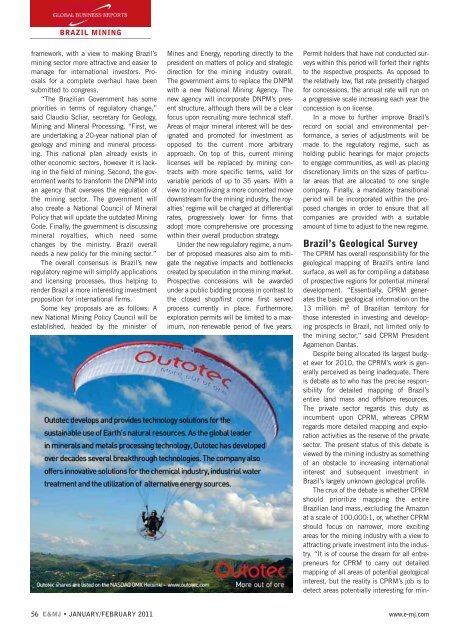Brazil Mining 2011 - GBR
Brazil Mining 2011 - GBR
Brazil Mining 2011 - GBR
Create successful ePaper yourself
Turn your PDF publications into a flip-book with our unique Google optimized e-Paper software.
BRAZIL MINING<br />
framework, with a view to making <strong>Brazil</strong>’s<br />
mining sector more attractive and easier to<br />
manage for international investors. Proosals<br />
for a complete overhaul have been<br />
submitted to congress.<br />
“The <strong>Brazil</strong>ian Government has some<br />
priorities in terms of regulatory change,”<br />
said Claudio Scliar, secretary for Geology,<br />
<strong>Mining</strong> and Mineral Processing. “First, we<br />
are undertaking a 20-year national plan of<br />
geology and mining and mineral processing.<br />
This national plan already exists in<br />
other economic sectors, however it is lacking<br />
in the field of mining. Second, the government<br />
wants to transform the DNPM into<br />
an agency that oversees the regulation of<br />
the mining sector. The government will<br />
also create a National Council of Mineral<br />
Policy that will update the outdated <strong>Mining</strong><br />
Code. Finally, the government is discussing<br />
mineral royalties, which need some<br />
changes by the ministry. <strong>Brazil</strong> overall<br />
needs a new policy for the mining sector.”<br />
The overall consensus is <strong>Brazil</strong>’s new<br />
regulatory regime will simplify applications<br />
and licensing processes, thus helping to<br />
render <strong>Brazil</strong> a more interesting investment<br />
proposition for international firms.<br />
Some key proposals are as follows: A<br />
new National <strong>Mining</strong> Policy Council will be<br />
established, headed by the minister of<br />
Mines and Energy, reporting directly to the<br />
president on matters of policy and strategic<br />
direction for the mining industry overall.<br />
The government aims to replace the DNPM<br />
with a new National <strong>Mining</strong> Agency. The<br />
new agency will incorporate DNPM’s present<br />
structure, although there will be a clear<br />
focus upon recruiting more technical staff.<br />
Areas of major mineral interest will be designated<br />
and promoted for investment as<br />
opposed to the current more arbitrary<br />
approach. On top of this, current mining<br />
licenses will be replaced by mining contracts<br />
with more specific terms, valid for<br />
variable periods of up to 35 years. With a<br />
view to incentivizing a more concerted move<br />
downstream for the mining industry, the royalties’<br />
regime will be charged at differential<br />
rates, progressively lower for firms that<br />
adopt more comprehensive ore processing<br />
within their overall production strategy.<br />
Under the new regulatory regime, a number<br />
of proposed measures also aim to mitigate<br />
the negative impacts and bottlenecks<br />
created by speculation in the mining market.<br />
Prospective concessions will be awarded<br />
under a public bidding process in contrast to<br />
the closed shop/first come first served<br />
process currently in place. Furthermore,<br />
exploration permits will be limited to a maximum,<br />
non-renewable period of five years.<br />
Permit holders that have not conducted surveys<br />
within this period will forfeit their rights<br />
to the respective prospects. As opposed to<br />
the relatively low, flat rate presently charged<br />
for concessions, the annual rate will run on<br />
a progressive scale increasing each year the<br />
concession is on license.<br />
In a move to further improve <strong>Brazil</strong>’s<br />
record on social and environmental performance,<br />
a series of adjustments will be<br />
made to the regulatory regime, such as<br />
holding public hearings for major projects<br />
to engage communities, as well as placing<br />
discretionary limits on the sizes of particular<br />
areas that are allocated to one single<br />
company. Finally, a mandatory transitional<br />
period will be incorporated within the proposed<br />
changes in order to ensure that all<br />
companies are provided with a suitable<br />
amount of time to adjust to the new regime.<br />
<strong>Brazil</strong>’s Geological Survey<br />
The CPRM has overall responsibility for the<br />
geological mapping of <strong>Brazil</strong>’s entire land<br />
surface, as well as for compiling a database<br />
of prospective regions for potential mineral<br />
development. “Essentially, CPRM generates<br />
the basic geological information on the<br />
13 million m 2 of <strong>Brazil</strong>ian territory for<br />
those interested in investing and developing<br />
prospects in <strong>Brazil</strong>, not limited only to<br />
the mining sector,” said CPRM President<br />
Agamenon Dantas.<br />
Despite being allocated its largest budget<br />
ever for 2010, the CPRM’s work is generally<br />
perceived as being inadequate. There<br />
is debate as to who has the precise responsibility<br />
for detailed mapping of <strong>Brazil</strong>’s<br />
entire land mass and offshore resources.<br />
The private sector regards this duty as<br />
incumbent upon CPRM, whereas CPRM<br />
regards more detailed mapping and exploration<br />
activities as the reserve of the private<br />
sector. The present status of this debate is<br />
viewed by the mining industry as something<br />
of an obstacle to increasing international<br />
interest and subsequent investment in<br />
<strong>Brazil</strong>’s largely unknown geological profile.<br />
The crux of the debate is whether CPRM<br />
should prioritize mapping the entire<br />
<strong>Brazil</strong>ian land mass, excluding the Amazon<br />
at a scale of 100,000:1, or, whether CPRM<br />
should focus on narrower, more exciting<br />
areas for the mining industry with a view to<br />
attracting private investment into the industry.<br />
“It is of course the dream for all entrepreneurs<br />
for CPRM to carry out detailed<br />
mapping of all areas of potential geological<br />
interest, but the reality is CPRM’s job is to<br />
detect areas potentially interesting for min-<br />
56 E&MJ • JANUARY/FEBRUARY <strong>2011</strong> www.e-mj.com
















